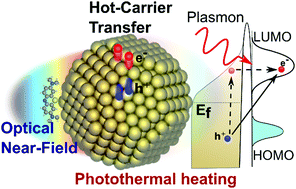Investigation of the mechanisms of plasmon-mediated photocatalysis: synergistic contribution of near-field and charge transfer effects†
Abstract
Plasmonic photocatalysis is an attractive way to drive and enhance chemical reactions. The relative importance of thermal and non-thermal effects in driving the reaction is still under debate in the literature, and the lack of a complete theoretical framework, discrepancies in nomenclature and contrasting experimental results continue to hinder the understanding of the underlying reaction mechanism. Particularly for small (<50 nm) nanoparticles (NPs), this has been exacerbated by limited in situ investigation of the relationships between morphology and performance. Here, we study the N-demethylation reaction of methylene blue (MB) adsorbed on disordered Au nanoparticle arrays with average size <50 nm as a model plasmonic photocatalytic system, by means of surface-enhanced Raman spectroscopy (SERS). The highest reaction yield is found under laser excitation at 633 nm, which overlaps both the plasmon and molecular resonance, however traces of products are found also off-resonance under illumination at 785 nm. Critically, we find that the reaction rate decreases as particle radius increases, showing a reduction of ca. 80% when the NP radius is increased from 5 nm to 32 nm. By employing multiscale modelling, we systematically report a mechanistic analysis of photothermal effects, near-field enhancements and hot-electron transfer in this system and address their relationship with NP size and reaction yield. This work demonstrates that both near-fields and hot-electrons synergistically cooperate in enhancing the N-demethylation reaction of MB and indicates that photothermal effects do not play a dominant role in this reaction. The results of this investigation contribute to the mechanistic understanding of plasmon-mediated reactions and provide insights for improved design of metal–molecule interfaces for efficient and selective photocatalysis.



 Please wait while we load your content...
Please wait while we load your content...